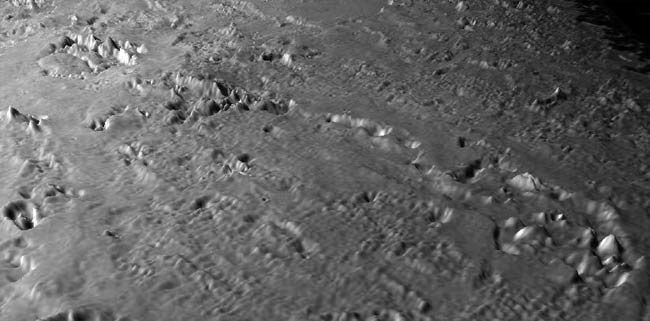Seasons Discovered on Neptune’s Moon Triton

The thin atmosphere of Neptune's moon Triton varies inthickness with the seasons and in the throes of summer, despite its relativelylarge distance from the sun compared to other bodies in the solar system, newobservations have found.
The European Southern Observatory's Very Large Telescope,located in Chile, made infrared observations of Tritonwhich show that summer is in full swing in the moon's southern hemisphere, andthat the warmth of the summer sun causes Triton's thin atmosphere to thicken.
"We have found real evidence that the sun still makesits presence felt on Triton, even from so far away," said EmmanuelLellouch of the Observatoire de Paris in France and a member of the team thatmade the discovery.
The telescope also discovered the presence of carbonmonoxide in Triton's atmosphere and made the first ground-based detection ofmethane on theNeptunian moon.
Of Neptune?s 13 moons, Triton is by far the largest, and, atabout 1,700 miles (2,700 km) in diameter (or three quarters of the diameter ofthe Earth?s moon), is the seventh largest moon in the whole solar system.
Since its discovery in 1846, Triton has fascinatedastronomers because of its geologic activity, the many different types ofsurface ices, such as frozen nitrogen aswell as water and dry ice (frozen carbon dioxide), and its uniqueretrograde motion (which means it rotates around its planet in the oppositedirection of its planet's rotation).
On Triton, where the average surface temperature is aboutminus 391 degrees Fahrenheit (minus 235 Celsius), it is currently summer in thesouthern hemisphere and winter in the northern.
Get the Space.com Newsletter
Breaking space news, the latest updates on rocket launches, skywatching events and more!
As Triton?s southern hemisphere warms up, a thin layer offrozen nitrogen, methane, and carbon monoxide on Triton?s surface sublimatesinto gas, thickening the icy atmosphere as the season progresses duringNeptune?s 165-Earth-year orbit around the sun.
A season on Triton lasts a little over 40 years, and Tritonpassed the southern summer solstice in 2000.
Based on the amount of gas measured, Lellouch and his colleaguesestimate that Triton's atmospheric pressure may have risen by a factor of fourcompared to the measurements made by Voyager2 in 1989, when it was still spring on the giant moon. The atmosphericpressure on Triton is now between 40 and 65 microbars ? 20,000 times less thanon Earth.
Carbon monoxide was known to be present as ice on thesurface, but Lellouch and his team discovered that Triton?s upper surface layeris enriched with carbon monoxide ice by about a factor of ten compared to thedeeper layers, and that it is this upper "film" that feeds theatmosphere.
While the majority of Triton?s atmosphere is nitrogen (muchlike Earth's, which is 78 percent nitrogen), the methane in the atmosphere,first detected by Voyager 2, and only now confirmed in this study from Earth,plays an important role as well.
"Climate and atmospheric models of Triton have to berevisited now, now that we have found carbon monoxide and re-measured themethane," said team member Catherine de Bergh, also of the Observatoire deParis.
The new observations of Triton's atmosphere are detailed inthe March 15 issue of the journal Astronomy & Astrophysics.
Pluto, often considered a cousin of Triton and with similarconditions, is receiving renewed interest in the light of the carbon monoxidediscovery, and astronomers are racing to find this chemical on the even moredistant dwarf planet.
- Top10 Extreme Planet Facts
- Images- Voyager?s Neptune Photos and More
- OddCloud on Neptune Seen Splitting Into Two
?
Join our Space Forums to keep talking space on the latest missions, night sky and more! And if you have a news tip, correction or comment, let us know at: community@space.com.

Space.com is the premier source of space exploration, innovation and astronomy news, chronicling (and celebrating) humanity's ongoing expansion across the final frontier. Originally founded in 1999, Space.com is, and always has been, the passion of writers and editors who are space fans and also trained journalists. Our current news team consists of Editor-in-Chief Tariq Malik; Editor Hanneke Weitering, Senior Space Writer Mike Wall; Senior Writer Meghan Bartels; Senior Writer Chelsea Gohd, Senior Writer Tereza Pultarova and Staff Writer Alexander Cox, focusing on e-commerce. Senior Producer Steve Spaleta oversees our space videos, with Diana Whitcroft as our Social Media Editor.









